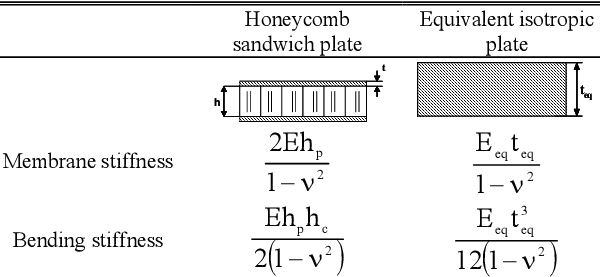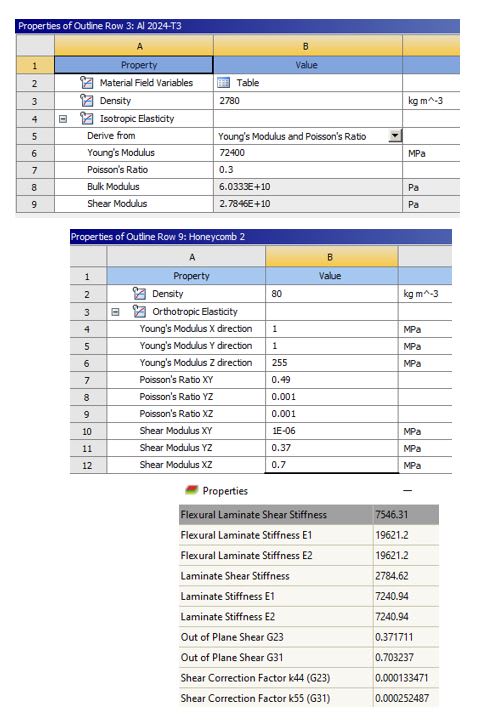Navigation
Install the app
How to install the app on iOS
Follow along with the video below to see how to install our site as a web app on your home screen.
Note: This feature may not be available in some browsers.
More options
Style variation
-
Congratulations MintJulep on being selected by the Eng-Tips community for having the most helpful posts in the forums last week. Way to Go!
You are using an out of date browser. It may not display this or other websites correctly.
You should upgrade or use an alternative browser.
You should upgrade or use an alternative browser.
Honeycomb Core Poisson Ratio 1
- Thread starter sarclee
- Start date
- Status
- Not open for further replies.
SWComposites
Aerospace
The core properties should not affect sandwich panel laminate properties, except the thru thickness normal and shear stiffnesses. Just use 0. for Poisson's ratio.
- Thread starter
- #3
Hi SWComposites, thanks for your reply!
I use my lamination excel tool to calculate the equivalent sandwich E or Bending Stiffness...for Aluminum facesheet and core but it seems not getting same value as the formula below...
For the formula below, is it correct that the E is the facesheet E? Thanks!

I use my lamination excel tool to calculate the equivalent sandwich E or Bending Stiffness...for Aluminum facesheet and core but it seems not getting same value as the formula below...
For the formula below, is it correct that the E is the facesheet E? Thanks!

-
1
- #4
SWComposites
Aerospace
Yes, both E and nu are for the facesheets.
The bending stiffness formula is wrong. Instead of hc should use (hc + hp). Ie distance between midplanes of facesheets.
The bending stiffness formula is wrong. Instead of hc should use (hc + hp). Ie distance between midplanes of facesheets.
- Thread starter
- #6
Thanks both SWComposites and rb1957!
So basically, the properties of honeycomb depends highly on the facesheet for in-plane properties... but bending would depend on the height of the core.
I was trying to see if Al sandwich can replace Al solid in term of light weight and more stiffer... but based on the calculation, although the weight can be saved about 20%, the stiffness is smaller except bending stiffness could be improved... unless otherwise using prepreg facesheet ..
So basically, the properties of honeycomb depends highly on the facesheet for in-plane properties... but bending would depend on the height of the core.
I was trying to see if Al sandwich can replace Al solid in term of light weight and more stiffer... but based on the calculation, although the weight can be saved about 20%, the stiffness is smaller except bending stiffness could be improved... unless otherwise using prepreg facesheet ..
"the properties of honeycomb" ... the properties of sandwich panel.
yes, a sandwich will have slightly lower bending stiffness than a solid plate, but much lower weight.
To retain the same bending stiffness, the sandwich panel would need to be slightly thicker.
To use "preg" or composite (Carbon, or E-glass) faces in lieu or Al would also restore stiffness, at the expense of material (and handling) costs.
another day in paradise, or is paradise one day closer ?
yes, a sandwich will have slightly lower bending stiffness than a solid plate, but much lower weight.
To retain the same bending stiffness, the sandwich panel would need to be slightly thicker.
To use "preg" or composite (Carbon, or E-glass) faces in lieu or Al would also restore stiffness, at the expense of material (and handling) costs.
another day in paradise, or is paradise one day closer ?
Also... a 'trick of the trade'... wherever a stress concentration occurs in a honeycomb panel or component...
The core is filled partially/discretely, or completely, with thermosetting potting compound. This is typically epoxy resin filled with glass or phenolic microballons or 'other low density/rigid fillers/reinforcement materials'... or are injection-filled with foaming [self expanding] epoxy/etc potting mixtures.
These compounds reinforce the filled honeycomb cell [added crush resistance] and rigidize the foil walls [from buckling/shear loads] and increase adhesion contact area and greatly increase resistance to moisture/fluids intrusion [filling voids and increased cell sealing].
Potting is invariably used at fastener [hole] penetrations with or without an embedded insert... and for areas that are machined 'thin/flimsy'.
Regards, Wil Taylor
o Trust - But Verify!
o We believe to be true what we prefer to be true. [Unknown]
o For those who believe, no proof is required; for those who cannot believe, no proof is possible. [variation,Stuart Chase]
o Unfortunately, in science what You 'believe' is irrelevant. ["Orion", Homebuiltairplanes.com forum]
The core is filled partially/discretely, or completely, with thermosetting potting compound. This is typically epoxy resin filled with glass or phenolic microballons or 'other low density/rigid fillers/reinforcement materials'... or are injection-filled with foaming [self expanding] epoxy/etc potting mixtures.
These compounds reinforce the filled honeycomb cell [added crush resistance] and rigidize the foil walls [from buckling/shear loads] and increase adhesion contact area and greatly increase resistance to moisture/fluids intrusion [filling voids and increased cell sealing].
Potting is invariably used at fastener [hole] penetrations with or without an embedded insert... and for areas that are machined 'thin/flimsy'.
Regards, Wil Taylor
o Trust - But Verify!
o We believe to be true what we prefer to be true. [Unknown]
o For those who believe, no proof is required; for those who cannot believe, no proof is possible. [variation,Stuart Chase]
o Unfortunately, in science what You 'believe' is irrelevant. ["Orion", Homebuiltairplanes.com forum]
- Thread starter
- #9
Another question about using core such as nomex, aluminum, foam. The stiffness is increasing for Alu >Nomex > foam but in calculation, we assume modulus is very small or negligible in pcomp or 2D analysis. How does the alu core stiffness being captured in the 2D FEA compared to foam core? Thanks!
SWComposites
Aerospace
Core properties are a function of the core density. So you can’t just state al > nomex > foam.
The only core stiffness properties that typically matter are the thru thickness shear moduli.
The only core stiffness properties that typically matter are the thru thickness shear moduli.
- Thread starter
- #11
SWComposites
Aerospace
Probably depends on the density of the foam core. I’m mostly familiar with honeycomb type cores.
- Thread starter
- #13
I am using ansys not nastran to model composite honeycomb. Both facesheet and core are aluminum, and I use lamination method to calculate the effective E, G and poisson ratio. Can I use these data with isotropic material model or I have to use orthotropic material model?
When I tried to use orthotropic material model, I could not get a reasonable results as I set all thru thickness properties to 1E-6. I get the result similar to isotropic model when I use same shear modulus in three axes...
When I tried to use orthotropic material model, I could not get a reasonable results as I set all thru thickness properties to 1E-6. I get the result similar to isotropic model when I use same shear modulus in three axes...
sarclee... FYI only...
Aluminum-skin + aluminum HC core + aluminum-skin is generally NOT referred-to as 'composite honeycomb [sandwich Assy]'... it is an aluminum honeycomb sandwich Assy.
To be a composite/hybrid honeycomb sandwich Assembly, at least one layer... one or both face-sheets and/or HC-core... must be non-metallic [fiber + resin].
Regards, Wil Taylor
o Trust - But Verify!
o We believe to be true what we prefer to be true. [Unknown]
o For those who believe, no proof is required; for those who cannot believe, no proof is possible. [variation,Stuart Chase]
o Unfortunately, in science what You 'believe' is irrelevant. ["Orion", Homebuiltairplanes.com forum]
Aluminum-skin + aluminum HC core + aluminum-skin is generally NOT referred-to as 'composite honeycomb [sandwich Assy]'... it is an aluminum honeycomb sandwich Assy.
To be a composite/hybrid honeycomb sandwich Assembly, at least one layer... one or both face-sheets and/or HC-core... must be non-metallic [fiber + resin].
Regards, Wil Taylor
o Trust - But Verify!
o We believe to be true what we prefer to be true. [Unknown]
o For those who believe, no proof is required; for those who cannot believe, no proof is possible. [variation,Stuart Chase]
o Unfortunately, in science what You 'believe' is irrelevant. ["Orion", Homebuiltairplanes.com forum]
SWComposites
Aerospace
sarclee - are you modelling the sandwich with a single shell element? Why not model facesheets with shells and core with solid element?
- Thread starter
- #17
@WKTaylor, thanks for pointing it out. I do agree with you. will be careful of the terms.
@SWComposites, yes. I am modeling the sandwich with a single shell element as I can quickly update the model for sizing.
But I notice a problem in ANSYS - thru thickness issue.
I make assumption for the core properties (set the modulus, shear modulus and poisson ratio to small value in three directions) and then I model the stack up Al facesheet + Al HC core + Al facesheet in Ansys but I notice that there is buckling mode appear in modal analysis which I do not expect it happens.
Same issue happen if I assume the Alu sandwich as orthotropic material with assuming very small value in thru thickness properties for G13, G23.
Note: I obtain E11, E22, V12 and G12 from lamination calculation and I use it to model sandwich in single shell by assuming it orthotropic.
Appreciate your thoughts!
@SWComposites, yes. I am modeling the sandwich with a single shell element as I can quickly update the model for sizing.
But I notice a problem in ANSYS - thru thickness issue.
I make assumption for the core properties (set the modulus, shear modulus and poisson ratio to small value in three directions) and then I model the stack up Al facesheet + Al HC core + Al facesheet in Ansys but I notice that there is buckling mode appear in modal analysis which I do not expect it happens.
Same issue happen if I assume the Alu sandwich as orthotropic material with assuming very small value in thru thickness properties for G13, G23.
Note: I obtain E11, E22, V12 and G12 from lamination calculation and I use it to model sandwich in single shell by assuming it orthotropic.
Appreciate your thoughts!
SWComposites
Aerospace
Ok, please post the exact properties that you are entering to Ansys, and the sandwich panel materials, material properties and thicknesses of the facesheets and core.
SWComposites
Aerospace
And the only thru thickness properties a shell element should need are G13 and G23.
- Thread starter
- #20
[UPDATE]
The plate shear modulus unit was wrong. The result looks reasonable after I fix it. Appreciate everyone for your kindness!
0.5 mm facesheet (Al 2024) + 9 mm HC + 0.5 mm facesheet (Al2024)
Based on the lamination calculation, E11 = 7240 Mpa, G12 = 2758 Mpa and V12 = 0.33
It seems the honeycomb core thru thickness properties might be wrong. I am checking the properties ...

The plate shear modulus unit was wrong. The result looks reasonable after I fix it. Appreciate everyone for your kindness!
0.5 mm facesheet (Al 2024) + 9 mm HC + 0.5 mm facesheet (Al2024)
Based on the lamination calculation, E11 = 7240 Mpa, G12 = 2758 Mpa and V12 = 0.33
It seems the honeycomb core thru thickness properties might be wrong. I am checking the properties ...

- Status
- Not open for further replies.
Similar threads
- Replies
- 4
- Views
- 351
- Replies
- 6
- Views
- 1K
- Locked
- Question
- Replies
- 6
- Views
- 680
- Locked
- Question
- Replies
- 20
- Views
- 790
- Locked
- Question
- Replies
- 6
- Views
- 477
